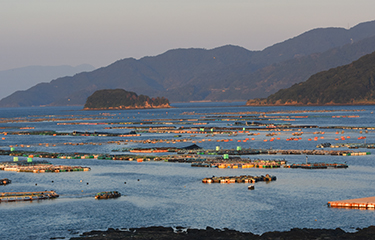Japan’s Fisheries Agency (JFA) announced in June its intention to boost farmed yellowtail production by over 70 percent – from under 140,000 metric tons (MT) currently, to 240,000 MT by the year 2030. However, a fingerling shortage will instead result in a short-term reduction.
Yellowtail fingerlings are typically sourced in the wild in Japan. Wild yellowtail fry (called mojako) are scooped into wellboats with handheld nets as they hide under rafts of seaweed drifting north from between Taiwan and Japan. The amount of such seaweed cover was low this summer, resulting in a lower catch and supply.
That fingerling shortage will stymie the country’s goal of boosting farmed production of fish of the genus Seriola (including the species S. quinqueradiata, S. lalandi, and S. rivoliana, known as hamachi/buri, hiramasa, and kampachi, respectively in Japanese).
Ryota Akizuki, a department head at Oita-based trading company SunDaico, told SeafoodSource at the Japan International Seafood and Technology Expo he estimates the shortfall of mojako this year at 30 percent. As a result, he is predicting a price-hike in two years, as it takes about two years for the fish to mature to harvest weight.
Even without the shortfall this year, for the country to reach its target level of production by 2030, it would need to scrap the current limits on the number of mojako that can be taken annually.
Unlike many catch limits, the yellowtail fingerling limits were not imposed with the sustainability of the resource in mind. Japan originally instituted the limit in the wake of a price crash following a glut of yellowtail hitting the market.
In 2012, 160,000 MT of cultured fish of the genus Seriola were produced, but the glut caused domestic wholesale prices to fall below the estimated producer break-even price of JPY 800 (USD 10.02, EUR 7.79 at the time). So, the government requested fishery cooperatives cut production to protect struggling family operators.
It enforced this by limiting the mojako harvest to 27 million fish for all Seriola species combined, which resulted in stable production slightly exceeding 130,000 MT since then.
Tomohiro (Tom) Asakawa, the deputy general secretary of the Japan Aquatic Products Export Council of the Japan Fisheries Association, said the announced production target was a top-down decision from the government – and that in order to implement it, it would be necessary to develop closed-cycle breeding.
Imports from South Korea, which also catches mojako, likely won’t be an option for some companies, according to Hisaaki Iwashita, assistant manager of the fish processing section at Azuma-cho Fisheries Cooperative Association – Japan’s largest producer of yellowtail.
“We don’t import from Korea. We have our own subsidiary with boats to harvest the chigyo [mojako],” Iwashita said. “We aren’t developing closed-cycle breeding, but if a university laboratory does it, we could buy them.”
So far, however, closed-cycle breeding has been relatively unsuccessful in Japan. Daisuke Arai, coordinator for research management of the planning and coordination department of the Fisheries Technology Institute of the Japan Fisheries Research and Education Agency (FRA), said that such research in closed-cycle breeding has already been successful in hatching out fry from eggs, but there is low survival when they are introduced to the sea. He noted that some overseas Seriola producers, such as Blue Ocean Mariculture in Hawaii, are successfully using closed-cycle breeding.
The FRA’s Goto Cultivation and Fisheries Center, located on an island off Kyushu where mojako are harvested, is experimenting with closed-cycle breeding. However, as the spawning season is dependent on the local climate, the location of the center, which is more northerly than the area where the fish normally spawn, leads to a two-month delay in spawning. This means either that smaller fish must be put into ocean pens, or that they must be stocked later in a sub-optimal period. Either results in lower survivability and slower growth. The center is conducting experiments in control of light and temperature to try to overcome the problem.
The Oita Marine Biological Technology Center of major Japanese seafood company Nissui, based in Tokyo, has reported more advanced successes in closed-cycle yellowtail breeding.
“By combining maturity control with breeding, we achieved year-round production of quick-growing artificial seedlings,” the company said. “This is the technology behind Kurose Yellowtail, including ‘Young Kurose Yellowtail,’ which is in season in early summer.”
Kindai University, which is famous for developing closed-cycle bluefin tuna, has successfully created a closed-cycle hybrid of hiramasa (male) and buri (female), which they call “burihira.” The hybrid has been sold through the Beisia supermarket chain, and contracted volumes have been steadily rising.
Though the scale is still small, closed-cycle breeding is gaining ground in Japan, and will be a key to raising production to the levels targeted by the government. However, whether that increase in domestic production will translate to another crash in price is still unknown.
“If it’s all exported, it’s no problem, but if it’s sold domestically, it’s a problem,” Iwashita said.
Photo courtesy of Miyuki39/Shutterstock







